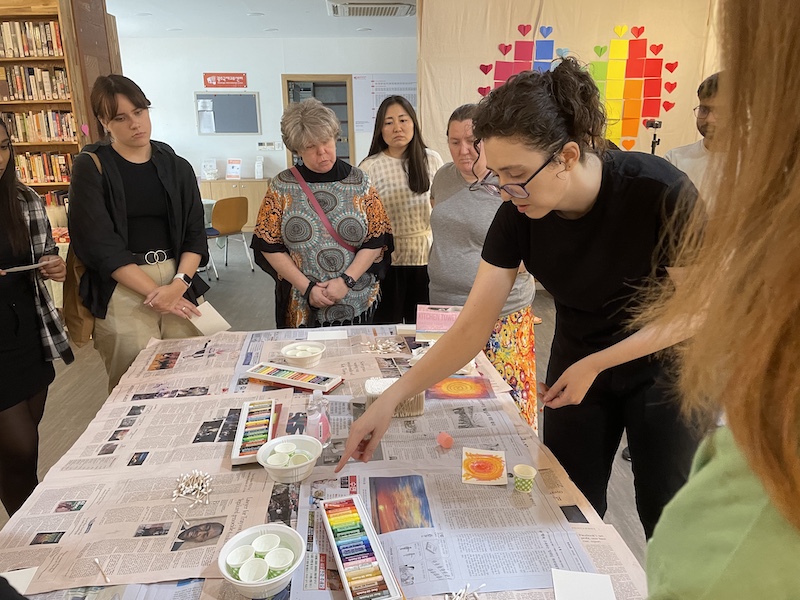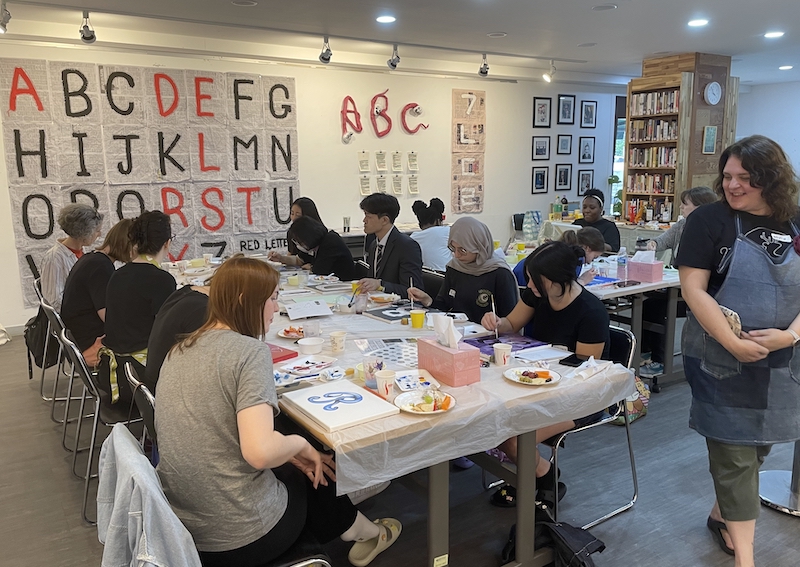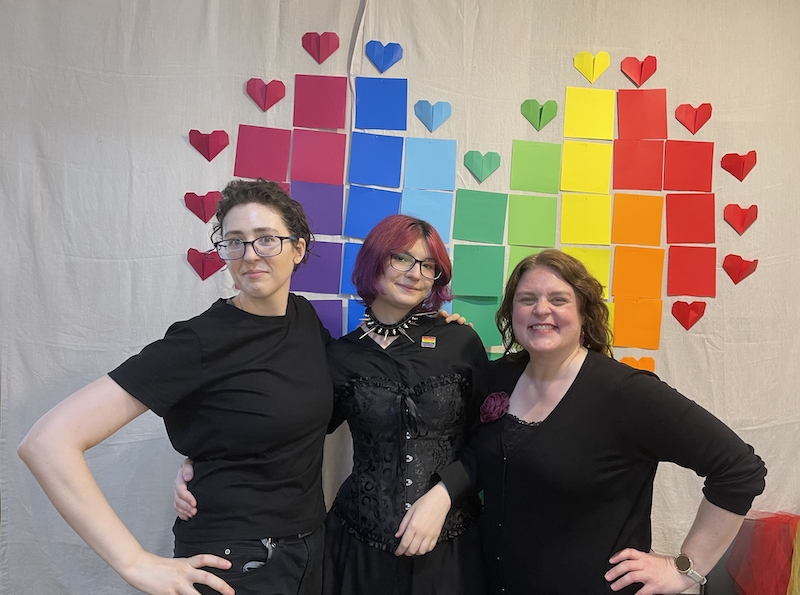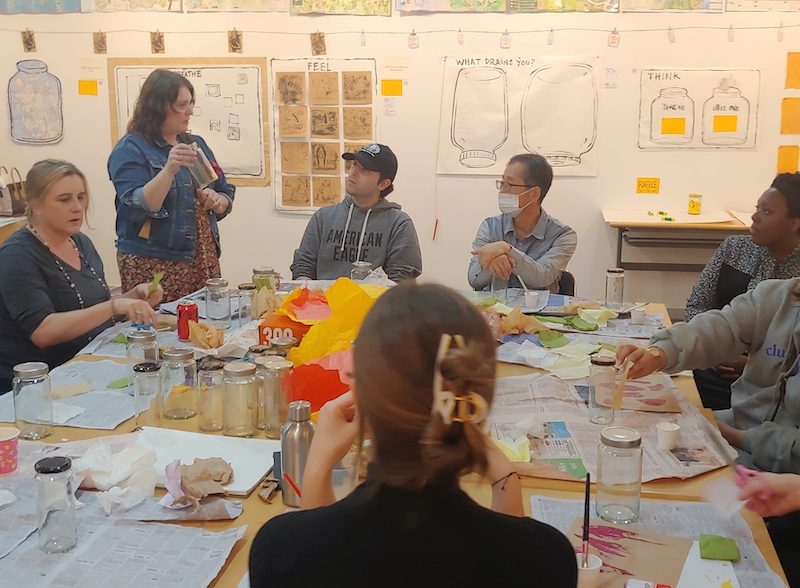Gwangju Art Class – Creating Space
By Lisa Casaus
When was the last time you let loose with some paints or crayons and just created something for the fun of it? When was the last time you did this with friends? For some of you, it might have been as far back as kindergarten. For others in the city, it might have been last Saturday, thanks to the Gwangju Art Class.
The Gwangju Art Class is a community art class that has been held at the Gwangju International Center since 2014. Originally created by Mariya Haponenko (Ukraine), it has been run by numerous volunteers throughout the years, and there have been classes in still life and live figure drawing, watercolor, embroidery, printmaking, and more.
In 2018 and 2019, Lisa Casaus (USA) and Raquib Hasan Apu (Bangladesh) took over coordination of the classes from Jen Lee (USA) and Ainé Byrne (Ireland), inheriting a well-stocked “Art Press” (closet), filled to bursting with brushes, paper, various paints and other supplies that must be carefully arranged like a puzzle box in order to shut the doors. We are so grateful for the space, but it can be a nightmare to fit in it all the supplies we’ve collected over the years!
In early 2020, Lisa Casaus, Olivia Laurel (USA), Laura Mie (UK), and Maya Galani (Romania) had just done a nice spring cleaning and organization of said closet when the pandemic mandates and meeting restrictions were announced. It was a full three years before we held another class, and during that time, that organization returned to chaos.
At the end of May 2023, after mask mandates had been lifted, it was the right time to do more spring cleaning and use those dusty art supplies! We also wanted to revive awareness about the Gwangju International Center (GIC) as an amazing resource for foreigners and Koreans alike. So, with the help of GIC staff and the messy art closet, a group of three artists started on a series of three exhibitions for the second half of 2023.
It’s Gotta Be Rainbows, the first exhibition in June, showcased the artwork of Casaus, Laurel, and Galani after some preliminary meetings and a “paint jam” on the second floor of the GIC. The idea was to use only items we had in the closet to create as much rainbow art as possible in a period of five to six hours. This was much harder than anticipated, and we all needed to use time outside to complete the work.

However, the rainbow theme was inspiring for the artists and visitors alike – especially at the end of the long period of Covid isolation – and we pulled together an amazing show. We had visitors from over ten different countries including Australia, Canada, Moldova, Serbia, Spain, South Africa, and the United Kingdom, with the bulk of participants from the United States and Korea.
This event featured rainbow snacks and station activities: rainbow card painting, collaborative art pieces, and an oil pastel demo and workshop. Participants viewed acrylic paintings by Laurel; were able to make postcards using Galani’s blob illustration technique; and finally, think about their mental, physical, and emotional wellbeing on a colorful spectrum chart designed by Casaus.
We came away from the event with the desire to do more; however, with school, teaching, and other responsibilities, our time was more limited. The following exhibitions were therefore masterminded by Casaus, with collaboration on installations and artwork by Laurel and assistance from Galani.
Red Letter Days, the second exhibition, was held in September to celebrate the Korean holidays of Chuseok (추석), National Foundation Day (개천절), and Hangul Day (한글날) at the end of September and beginning of October.
This year had an especially long Chuseok holiday ending on the last weekend of September. Foundation Day followed immediately on Tuesday (October 3). Because of this, the Korean government instituted a temporary “bridge” holiday on Monday to fill the gap. A six-day break was certainly cause for celebration!
In addition, the show’s theme played on the importance of individual letters and alphabets, such as Hangul (invented by the much-beloved king Sejong the Great and celebrated on October 9), as well as the English idiom “It’s a red-letter day.” This idiom references the ancient practice (in Rome, China, etc.) of marking special days on calendars in red – a practice which is still used in Korea today. A red-letter day is a memorable or noteworthy day. Our goal was to remind viewers of special days in their home countries as they celebrated the red days (공휴일) in Korea.

Casaus used the old riddle, “What is black and white, and red (read) all over?” to inspire the use of newspapers as a base for all of the art work. The art was simple and recyclable but large and impactful, and created collaboratively. Laurel used her envelope folding skills to create a wall of envelopes (red envelopes) as well as providing her assorted collection of glass bottles to form the basis of installations for all three shows.
Laurel’s wine bottles (red wine, of course!), paired nicely with the paint-and-sip event held on September 23. Participants painted monogram-style letters inspired by illuminated manuscripts of the European Middle Ages, when the use of “red letter day” was first recorded in the Western world (~1385).

The response to the event was as positive as the June event. Laurel prepared individual place settings, like a sit-down dinner, with paintbrushes in lieu of forks. Wine and cheese encouraged relaxation while painting. The participants from seven different countries, including France, Germany, and Scotland, requested that we do more events like this in the future.
We were eager! However, at this point, our closet was fuller than when we started. To try to solve this problem, we decided to do two events in the month of November and began the concepting process for the next show.
Connecting the Flow: Leave the Door Ajar, the third exhibition, was born out of Casaus’s desire to create a multimodal wellness experience around the flow of mental and physical health, and Laurel’s desire to use her large collection of glass jars. The season’s fall leaves and another riddle formed the tail end of the exhibition’s title: “Q: When is a door not a door? A: When it’s ajar.”
Leaving the door ajar is a lesson in keeping an open heart and mind. It was necessary to learn in this case as well, as preparation for this show did anything but flow smoothly. Laurel had a collection of maps of Korea, and specifically Jeollanam-do, which formed the basis of the visuals for the entire show, but due to events in October, it was impossible to schedule a time to hang the artwork in one session. Without the maps on the walls, the other art lacked focus. Another challenge was preparing the station activities so that they – you guessed it – flowed. Thankfully, additional brainstorming and set-up help came from digital artist Tayla Botha (South Africa), who searched out and prepared prompts for each activity station.
The first Connect the Flow event was held on November 11 and consisted of two sessions. The first session focused on mindfulness exercises, which included activities for breath and body awareness, awareness of positive and negative thinking, and connecting the flow of energy between the body and mind.
Casaus created infographics and signs to direct participants to stations as well as a series of hand-carved stamps to be used in the wellness zines. Participants went to stations to read the prompts and then wrote in their zines at a main table in the center of the room. Finally, they were able to use and collect stamps in the fashion of a passport. Above them, the maps echoed the flow of their journey back and forth between the stations and their zines. (Note: A “zine,” short for “magazine,” is handmade and/or self-published in small editions.)
At the leaf-printing station, participants used freshly fallen leaves to create a monoprint on paper. After completing this, they were encouraged to use their leaves to make one last print on a communal tree, effectively putting the fallen leaves back onto the branches and connecting the flow of seasons and growth.
The last station was focused on letting go. Participants were provided with red paper and pens. They were tasked to write a short letter to themselves consisting of a negative thought, or someone they needed to forgive – including themselves. After writing, their mission was to tear that letter into the smallest possible pieces and throw the pieces into a large jar of water.
During the second session, Laurel demonstrated decoupage of paper onto glass jars to create glowing lanterns. Participants used Korean hanji paper, pressed leaves, and glue to cover the jars. After completion, a temporary installation was formed and the lanterns were lit with candles. The resulting ring of glowing lanterns seemed to connect the living and the dead, and the connections came full circle as breath extinguished the flames.
We held our second paint-and-sip event the following Saturday, November 18. The mandala theme was a way to encourage mindfulness and the flow of organic creativity. A mandala (Sanskrit for “circle” or “central”) is a geometric design that radiates from a central point, using repetition and patterns to (ideally) reach a meditative state. Mandalas are significant in various spiritual practices around the world, including Buddhism and Hinduism. In preparation for the event, Laurel created mandalas on fabric and canvas as examples and gave a painting demonstration of her techniques. Casaus and Galani assisted by walking around to check on guests’ progress.

This second paint-and-sip had guests from nine different countries, including Puerto Rico and Ireland, with the most participants from South Africa. We filled up the GIC lounge and quickly ran out of wine, much to the disappointment of latecomers. However, everyone was able to create some amazing art. It was a resounding success thanks to the administration of sign-ups and social-media marketing by Laurel.
Now, at the end of 2023, we are proud to say that the Gwangju Art Class provided some much-needed creative space and community building after the long isolation of the pandemic. We have met new friends from different countries, and they are eager to continue meeting and making art together.
During December, two open-house-style workshops and flea markets were held (to help clean out the closet). Making cards to enjoy the pleasure of the holiday season, we commemorated our experiences in Gwangju during 2023. However, these may be among the last classes for some time. Casaus and Laurel are both leaving Korea in early 2024 and Galani is still a student. The Gwangju Art Class needs new volunteers to take up the torch. So, take this as a reminder to reach out and share your talents. You are a source of culture, inspiration, and knowledge.
We hope you, the community of Gwangju, continue to use the Gwangju International Center as a resource for clubs and events, a meeting space, and a source of funding. We hope there is always a space for sharing our collective experiences and creative expression – because, also, we still need to clean out the closet!
All the best, Gwangju Art Lovers.
The Gwangju Art Class
The Artists
Olivia Laurel is from Bremerton, Washington. In March 2022, she organized and participated in the Expressions group exhibition at Gwangju University’s Hosim Gallery. It consisted of art from six female artists to illustrate a collective experience of the then-ongoing pandemic. You can see her art on Instagram @gallerybluespot.
Maya Galani is from Bucharest, Romania. She is currently studying traditional Korean painting in Gwangju, with plans to study art in Europe after graduation. She is skilled in colored pencil techniques, fluorescent animal portraits, and fashion. She has been an active participant and assistant in the Gwangju Art Class since 2019. You can see her art on Instagram @zzswiftyzz.

The Author
Lisa Casaus is from Albuquerque, New Mexico. She has been teaching English in Korean elementary schools since 2016, while developing her portfolio and preparing to apply to artist residencies around the world. She was the volunteer coordinator of the Gwangju Art Class from 2018 to 2020 and again in 2023. You can see her art at www.lisacasaus.com.



